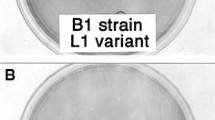Summary
Adeno 7 virus replicated well in human diploid (LEP) cells but only to a low degree in green monkey kidney (GMK) cells at 37° C; it did not replicate in either system at 29° C. At 37° C SV40 virus replicated well in GMK cells but only moderately in LEP cells; at 29° C it did not replicate in either system. SV40-adeno 7 hybrid grew in both GMK cells and LEP cells at 37° C. At 29° C this virus replicated in GMK cells but not in LEP cells. While the formation of V-antigen generally corresponded to the infectious virus production in the respective system, considerable differences were encountered in the T-antigens production. Adeno 7 T-antigen was detected earlier and in a higher percentage of GMK cells than in the fully permissive LEP cells and its formation was only slightly influenced by the incubation temperature. SV40 T-antigen was more efficiently formed in GMK cells than in LEP cells. At 29° C SV40 T-antigen was only found in GMK cells and was detected later than at 37° C. The difference in the formation of SV40 T-antigen in GMK cells infected with SV40 and SV40-adeno 7 hybrid virus was further analyzed. The results obtained suggest that an early step of the virus-cell interaction, but neither virus attachment nor penetration, was involved.
Similar content being viewed by others
References
Altstein, A. D., N. N. Dodonova, andN. N. Vasilyeva: The effect of incubation temperature on the cytopathic activity, plaque formation and multiplication of vacuolating virus SV 40. Acta virol.9, 144–151 (1965).
Ashkenazi, A., andJ. L. Melnick: Tumorigenicity of simian papovavirus SV 40 and of virus-transformed cells. J. nat. Cancer Inst.30, 1227–1265 (1963).
Baum, S. G., W. H. Wiese, andP. R. Reich: Studies on the mechanism of enhancement of adenovirus 7 infection in African green monkey cells by simian virus 40: Formation of adenovirus—specific RNA. Virology34, 373–376 (1968).
Boeyé, A., J. L. Melnick, andF. Rapp: SV 40-adenovirus “hybrids”: Presence of two genotypes and the requirement of their complementation for viral replication. Virology28, 56–70 (1966).
Bresnick, E., andF. Rapp: Thymidine kinase activity in cells abortively and productively infected with human adenoviruses. Virology34, 799–801 (1968).
Butel, J. S., andF. Rapp: Replication in simian cells of defective viruses in an SV 40-adenovirus “hybrid” population. J. Bact.91, 278–284 (1966).
Butel, J., andF. Rapp: Complementation between a defective monkey cell-adapting component and human adenoviruses in simian cells. Virology31, 573–584 (1967).
Carp, R. I., andR. V. Gilden: A comparison of the replication cycles of simian virus 40 in human diploid and African green monkey kidney cells. Virology28, 150–162 (1966).
Crouch, N. A., andF. Rapp: Cell-dependent differences in the production of infectious herpes simplex virus at a supraoptimal temperature. J. Virol.9, 223–230 (1972).
Feldman, L. A., J. S. Butel, andF. Rapp: Interaction of a simian papovavirus and adenoviruses. I. Induction of adenovirus tumor antigen during abortive infection of simian cells. J. Bact.91, 813–818 (1966).
Fox, R. J., andS. G. Baum: Synthesis of viral ribonucleic acid during restricted adenovirus infection. J. Virol.10, 220–227 (1972).
Gilden, R. V., J. Kern, Y. K. Lee, andR. J. Huebner: Biological separation of adenovirus T and V antigen synthesis in KB cells. Proc. Soc. exp. Biol. (N.Y.)127, 639–642 (1968).
Kitahara, T., andJ. L. Melnick: Thermal separation of the synthesis of papovavirus SV 40 tumor and virus antigens. Proc. Soc. exp. Biol. (N.Y.)120, 709–712 (1965).
Kutinová, L., andV. Vonka: Growth of the SV 40-adeno 7 hybrid virus in human diploid cells. Int. J. Cancer3, 344–350 (1968).
Malmgren, R. A., A. S. Rabson, P. G. Carney, andF. J. Paul: Immunofluorescence of green monkey kidney cells infected with adenovirus 12 and adenovirus 12 plus simian virus 40. J. Bact.91, 262–265 (1966).
Naegele, R. F., andF. Rapp: Enhancement of the replication of human adenoviruses in simian cells by simian adenovirus SV 15. J. Virol.1, 838–840 (1967).
Oxman, M. N.: Some behavioral studies of simian virus 40 (SV 40). Arch. ges. Virusforsch.22, 171–187 (1967).
Pereira, H. G.: A protein factor responsible for the early cytopathic effect of adenoviruses. Virology6, 601–611 (1958).
Rapp, F., J. S. Butel, andJ. L. Melnick: SV 40-adenovirus “hybrid” populations: Transfer of SV 40 determinants from one type of adenovirus to another. Proc. nat. Acad. Sci. (Wash.)54, 717–724 (1965).
Rapp, F., L. A. Feldman, andM. Mandel: Synthesis of virus deoxyribonucleic acid during abortive infection of simian cells by human adenoviruses. J. Bact.92, 931–936 (1966).
Rapp, F., M. Jerkofsky, andD. Vanderslice: Characterization of defectiveness of human adenoviruses in green monkey kidney cells. Proc. Soc. exp. Biol. (N.Y.)126, 782–786 (1967).
Rhim, J. S., K. Schell, H. C. Turner, andR. J. Huebner: Temperature dependence of the synthesis of adenovirus tumor and viral antigens. Proc. Soc. exp. Biol. (N.Y.)127, 642–646 (1968).
Rowe, W. P., andS. G. Baum: Studies of adenovirus SV 40 hybrid viruses. II. Defectiveness of the hybrid particles. J. exp. Med.122, 955–966 (1965).
Szántó, J., andJ. Leššo: Adaptation of herpes simplex virus type 1 to supra-optimal temperature. I. Biological properties of cells and virus adapted to 40° C. Acta virol.18, 323–331 (1974).
Vonka, V., J. Kára, L. Kutinová, andH. Závadová: Effect of temperature on synthesis of T and V antigens of papovavirus SV 40 and induction of thymidine kinase. Arch. ges. Virusforsch.28, 251–254 (1969).
Vonka, V., H. Závadová, L. Kutinová, andD. Řezáčová: Development of antibodies against viral and tumor antigens of papovavirus SV 40 in monkeys. Proc. Soc. exp. Biol. (N.Y.)125, 790–794 (1967).
Author information
Authors and Affiliations
Additional information
With 5 Figures
Rights and permissions
About this article
Cite this article
Kutinová, L. Growth of SV40, adeno 7 and SV40-adeno 7 viruses in monkey and human cells at 29° and 37°C. Archives of Virology 47, 257–268 (1975). https://doi.org/10.1007/BF01317813
Received:
Issue Date:
DOI: https://doi.org/10.1007/BF01317813




